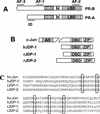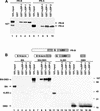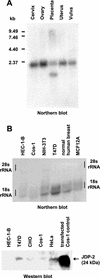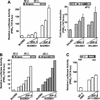Jun dimerization protein 2 functions as a progesterone receptor N-terminal domain coactivator
- PMID: 12101239
- PMCID: PMC133955
- DOI: 10.1128/MCB.22.15.5451-5466.2002
Jun dimerization protein 2 functions as a progesterone receptor N-terminal domain coactivator
Abstract
The progesterone receptor (PR) contains two transcription activation function (AF) domains, constitutive AF-1 in the N terminus and AF-2 in the C terminus. AF-2 activity is mediated by a hormone-dependent interaction with a family of steroid receptor coactivators (SRCs). SRC-1 can also stimulate AF-1 activity through a secondary domain that interacts simultaneously with the primary AF-2 interaction site. Other protein interactions and mechanisms that mediate AF-1 activity are not well defined. By interaction cloning, we identified an AP-1 family member, Jun dimerization protein 2 (JDP-2), as a novel PR-interacting protein. JDP-2 was first defined as a c-Jun interacting protein that functions as an AP-1 repressor. PR and JDP-2 interact directly in vitro through the DNA binding domain (DBD) of PR and the basic leucine zipper (bZIP) region of JDP-2. The two proteins also physically associate in mammalian cells, as detected by coimmunoprecipitation, and are recruited in vivo to a progesterone-inducible target gene promoter, as detected by a chromatin immunoprecipitation (ChIP) assay. In cell transfection assays, JDP-2 substantially increased hormone-dependent PR-mediated transactivation and worked primarily by stimulating AF-1 activity. JDP-2 is a substantially stronger coactivator of AF-1 than SRC-1 and stimulates AF-1 independent of SRC-1 pathways. The PR DBD is necessary but not sufficient for JDP-2 stimulation of PR activity; the DBD and AF-1 are required together. JDP-2 lacks an intrinsic activation domain and makes direct protein interactions with other coactivators, including CBP and p300 CBP-associated factor (pCAF), but not with SRCs. These results indicate that JDP-2 stimulates AF-1 activity by the novel mechanism of docking to the DBD and recruiting or stabilizing N-terminal PR interactions with other general coactivators. JDP-2 has preferential activity on PR among the nuclear receptors tested and is expressed in progesterone target cells and tissues, suggesting that it has a physiological role in PR function.
Figures










Similar articles
-
Progesterone receptor interacting coregulatory proteins and cross talk with cell signaling pathways.J Steroid Biochem Mol Biol. 2002 Dec;83(1-5):173-86. doi: 10.1016/s0960-0760(02)00265-0. J Steroid Biochem Mol Biol. 2002. PMID: 12650714
-
Partial agonist activity of the progesterone receptor antagonist RU486 mediated by an amino-terminal domain coactivator and phosphorylation of serine400.Mol Endocrinol. 2010 Feb;24(2):335-45. doi: 10.1210/me.2008-0081. Epub 2009 Dec 11. Mol Endocrinol. 2010. PMID: 20008003 Free PMC article.
-
Regulation of the amino-terminal transcription activation domain of progesterone receptor by a cofactor-induced protein folding mechanism.Mol Cell Biol. 2005 Oct;25(20):8792-808. doi: 10.1128/MCB.25.20.8792-8808.2005. Mol Cell Biol. 2005. PMID: 16199860 Free PMC article.
-
Role of co-activators and co-repressors in the mechanism of steroid/thyroid receptor action.Recent Prog Horm Res. 1997;52:141-64; discussion 164-5. Recent Prog Horm Res. 1997. PMID: 9238851 Review.
-
Minireview: role of kinases and chromatin remodeling in progesterone signaling to chromatin.Mol Endocrinol. 2010 Nov;24(11):2088-98. doi: 10.1210/me.2010-0027. Epub 2010 May 19. Mol Endocrinol. 2010. PMID: 20484412 Free PMC article. Review.
Cited by
-
Kruppel-like factor 2 (KLF2) regulates proinflammatory activation of monocytes.Proc Natl Acad Sci U S A. 2006 Apr 25;103(17):6653-8. doi: 10.1073/pnas.0508235103. Epub 2006 Apr 14. Proc Natl Acad Sci U S A. 2006. PMID: 16617118 Free PMC article.
-
ATF3 and JDP2 deficiency in cancer associated fibroblasts promotes tumor growth via SDF-1 transcription.Oncogene. 2019 May;38(20):3812-3823. doi: 10.1038/s41388-019-0692-y. Epub 2019 Jan 22. Oncogene. 2019. PMID: 30670778 Free PMC article.
-
Jun dimerization protein 2 controls senescence and differentiation via regulating histone modification.J Biomed Biotechnol. 2011;2011:569034. doi: 10.1155/2011/569034. Epub 2010 Dec 12. J Biomed Biotechnol. 2011. PMID: 21197464 Free PMC article. Review.
-
Nuclear receptor coactivator function in reproductive physiology and behavior.Biol Reprod. 2003 Nov;69(5):1449-57. doi: 10.1095/biolreprod.103.019364. Epub 2003 Jul 9. Biol Reprod. 2003. PMID: 12855594 Free PMC article. Review.
-
Who's in charge? Nuclear receptor coactivator and corepressor function in brain and behavior.Front Neuroendocrinol. 2009 Aug;30(3):328-42. doi: 10.1016/j.yfrne.2009.04.008. Epub 2009 May 4. Front Neuroendocrinol. 2009. PMID: 19401208 Free PMC article. Review.
References
-
- Allan, G., S. Leng, S. Tsai, N. Weigel, D. Edwards, M.-J. Tsai, and B. O'Malley. 1992. Hormone and antihormone induce distinct conformational changes which are central to steroid receptor activation. J. Biol. Chem. 267:19513-19520. - PubMed
-
- Bain, D., M. Franden, J. McManaman, G. Takimoto, and K. Horwitz. 2000. The N-terminal region of the human progesterone A-receptor. J. Biol. Chem. 275:7313-7320. - PubMed
-
- Baudino, T., D. Kraichely, S. Jefcoat, Jr., S. Winchester, N. Partridge, and P. MacDonald. 1998. Isolation and characterization of a novel coactivator protein, NCoA-62, involved in vitamin D-mediated transcription. J. Biol. Chem. 273:16434-16441. - PubMed
Publication types
MeSH terms
Substances
Grants and funding
LinkOut - more resources
Full Text Sources
Molecular Biology Databases
Research Materials
Miscellaneous
